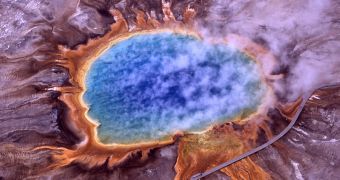Investigators in the United States recently used seismic wave measurements from earthquakes to take a look at the magma chamber of hot molten rock that swirls under the Yellowstone National Park. The conclusions of the study are very worrying – the chamber is 2.5 times larger than what scientists first calculated.
The team, based at the University of Utah, presented details of the findings at the American Geophysical Union meeting, which took place recently in San Francisco, California. According to data from the US Geological Survey, Yellowstone last erupted 640,000 years ago, Daily Galaxy reports.
The latest measurements conducted at the supervolcano – the last active volcano of its type in the world – indicate that Yellowstone could erupt with 2,000 times the power of Mount St. Helens. Geologists say that an eruption at Yellowstone would be a global disaster. The entire surface of the US would be covered in ash in less than a week.
The ash plumes generation by a potential eruption will have the potential to block out sunlight for a long time, and cause widespread vegetation extinctions. It could only take one magnitude 7 earthquake to set off a blast at Yellowstone, many geologists agree.
The new investigation, spearheaded by lead study author Jamie Farrell determined that the magma chamber below the volcano is no less than 88.5 kilometers (55 miles) long and 29 kilometers (18 miles) wide. In terms of depth, the chamber can reach between 4.8 to 14.5 kilometers (3 to 9 miles)
These measurements suggest that the magma chamber has sufficient material within to match the strength of Yellowstone's strongest eruption, which was recorded around 2.1 million years ago. “We do believe there will be another eruption, we just don’t know when,” the expert says.
Earthquake swarms under the volcano have been monitored for years, and some researchers have been arguing that Yellowstone is long overdue for a blast. However, Farrell says, there are currently not enough data to make that prediction with any kind of certainty.
At the same time, recent reports have suggested that the caldera of the supervolcano has been rising steadily since 2004. This has been interpreted by some as suggesting that more and more magma is accumulating inside the chamber ahead of an impending eruption. Not all researchers agree, however.
“There is no evidence of an imminent volcanic eruption or hydrothermal explosion. That’s the bottom line. A lot of calderas worldwide go up and down over decades without erupting,” comments Robert B. Smith, a seismologist and professor of geophysics at the University of Utah.

 14 DAY TRIAL //
14 DAY TRIAL //